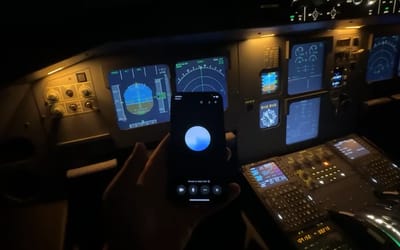80-year-old flying boat from WW2 era takes retirement flight soaring over Golden Gate Bridge to Arizona
- The Philippine Mars is one of the most unique planes ever created.
- The sea bomber was built by the Martin Company during WWII
- Now, though, two of the final surviving planes are being retired.
Published on Feb 18, 2025 at 8:24 PM (UTC+4)
by Keelin McNamara
Last updated on Feb 18, 2025 at 8:25 PM (UTC+4)
Edited by
Tom Wood
The Philippine Mars plane did something very cool last week.
The World War II-era water bomber – the only plane of its kind – took its retirement flight to Arizona.
The 80-year-old seaplane took off from British Columbia, before making a stunning stop in San Francisco.
This sort of thing is always worth celebrating.
DISCOVER SBX CARS: The global premium car auction platform powered by Supercar Blondie
Philippine Mars: a flying boat from a bygone era
The Martin JRM Mars seaplane is one of the most eye-catching aircraft ever created.
It was designed by the Martin Company as a four-engine cargo transport plane for the United States Navy during World War II.
Sadly, only seven of these Magnificent Martin JRM Mars aircraft were ever built, but they were still the largest Allied flying boat to enter service.

Four of the magnificent seven aircraft survived the war, and all were converting to forest fire fighters.
Two of the aircraft, the Philippine and the Hawaii Mars, remained based at Sproat Lake, just outside Port Alberni, British Columbia.
It’s safe to say that these floating fortresses have a truly magnificent and distinguished history.
Flying into the sunset: Mars heads for retirement
Sadly, all good things must come to an end, and the Philippine Mars is no exception.
On April 1st, 2024, Coulson Aviation, the company that own both planes, announced that the sister plane, the Hawaii Mars, would be donated to the British Columbia Aviation Museum.
24 days later, the company made the announcement that the Philippine Mars would be donated to the Pima Air & Space Museum in Tucson, Arizona.
On February 9th, Philippine Mars left Sproat Lake for the final time before (appropriately) migrating south.
After completing a landing in San Francisco Bay, the plane spent the night in San Francisco before completing it’s final journey to Lake Pleasant, Arizona – completing a stunning flyover of the Golden Gate Bridge in the process.
Watch the WWII flying boat the Philippine Mars soar over the Golden Gate Bridge. The 80-year-old plane — which lands and takes off from water — made an 800-mile journey to the Bay Area from British Colombia. It will retire at the Pima Air and Space Museum in Tucson, Arizona. pic.twitter.com/i4okIB7B2X
— ABC7 News (@abc7newsbayarea) February 10, 2025
Aviation historian Gary Plomp was asked for his opinion on the significance of the event.
He had this to say: “To see a sea plane land again on a body of water, a sea plane this large, is something I don’t think you’ll ever see again. There’s smaller ones, but something this magnificent and imposing and beautiful.”
The Philippine Mars was given an escort for it’s final journey to Arizona, including being flanked by a P51-D Mustang.
Keelin McNamara is a content writer at Supercar Blondie from Ireland, covering cars, technology, and lifestyle. Despite being a Law graduate, he discovered his passion for journalism during the COVID-19 pandemic, and has worked in the industry ever since. Outside of work, he is an avid MotoGP fan, and is a self-confessed addict of the sport.




